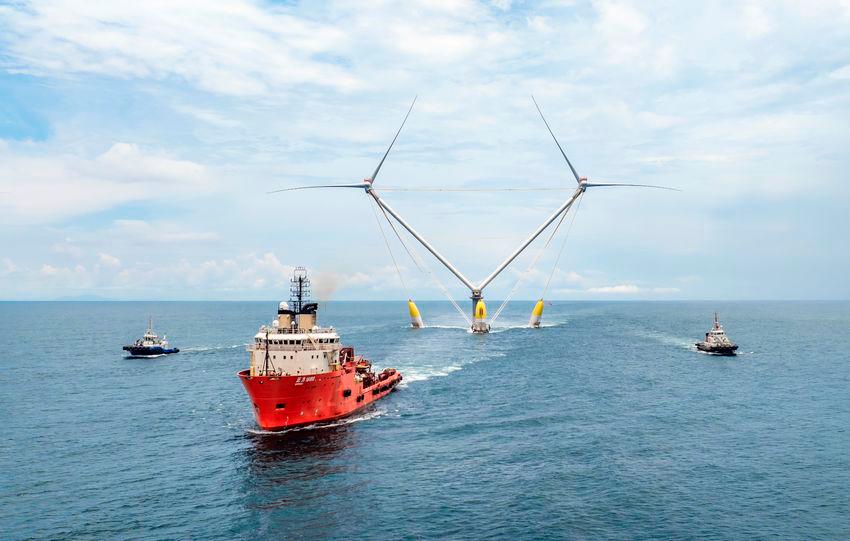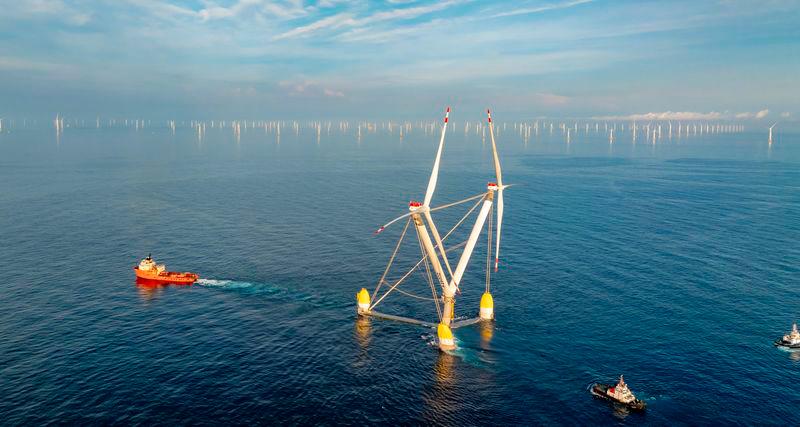GUANGZHOU, CHINA - Media OutReach Newswire - 19 August 2024 - On August 13, OceanX, the world’s largest single capacity floating wind power platform, embarked on its journey from Guangzhou to the Yangjiang Mingyang Qingzhou IV offshore wind farm in Guangdong, China. After a 191-nautical-mile, over 50-hour tow, the platform’s arrival marks the commencement of a new era in green energy, poised to set the standard for offshore wind power technology.
Developed by Mingyang Group, this floating wind turbine platform is arranged in a ‘V’ shape and carries two 8.3 MW offshore wind turbines. With a total capacity of 16.6 MW, it can be used in a wide range of sea areas around the world with water depth of more than 35 metres.
OceanX impeller reaches 219 metres at its highest point and a maximum width of about 369 metres in the air. The whole wind turbine platform has a total displacement of 15,000 tonnes, and a towing draft of 5.5 meters. Once operational, it is expected to produce 54 million kWh annually, enough to power 30,000 three-person households for a year.
High-Tech Ingenuity: OceanX Floats on Cutting-Edge Materials
OceanX advances wind turbine innovation by enhancing core component technology, driving both aesthetic and functional refinement in design and manufacturing.
Floating foundation is the key component for floating wind turbines in the deep and distant sea. Unlike traditional steel floating foundations, OceanX’s floating foundation consists of three floats, concrete arms and connectors.
It pioneers the use of ultra-high performance concrete with a compressive strength exceeding 115 MPa for floating foundation construction, a material 4 times stronger than standard concrete, significantly enhancing load-bearing capacity. The floating foundation also utilizes a pre-stressed high-strength concrete assembly structure, facilitating modular and batched manufacturing, thereby substantially reducing construction costs.
Mingyang has leveraged caisson pre-tensioning technology in its precast concrete construction, emphasizing interface sealing and the precision of the pre-stressing process. With 1,500 steel strands expertly threaded through the floating body’s arm, it has meticulously controlled tensioning forces and ensured uniform stress across the end face throughout the construction.
OceanX also introduces a cutting-edge float design, using layered material to replace traditional steel or hybrid materials. The float lightens the floats and accommodates their curved form. The three streamlined ellipsoidal floats offer reduced wave resistance and enable lateral rotation, providing yawing power. Rigorous testing confirms that the streamlined shape strikes an ideal balance between stability and load-bearing.
Notably, housing two wind turbines on a single floating platform can significantly cut down the per-kilowatt cost, as well as reduce the required sea area and operational maintenance expenses.
Revolutionary ‘V’ Tower: OceanX Pioneers Wind Turbine Architecture
OceanX, with its robust floating foundation, features the integration of two towers in a ‘V’ configuration, marking a first for offshore wind platforms.
OceanX’s tower, with its elongated elliptical design, maximizes wind exposure along its longer axis, significantly exceeding that on the shorter axis. By aligning the tower with the wind direction at an optimal angle, the wind platform’s area is effectively increased, allowing for swifter alignment to the wind and boosting the efficiency of wind energy capture. Additionally, the towers are fitted with a dual-access system for lifts and ladders, ensuring the comfort and safety of personnel during ascent and descent.
In addition to the evolution of the wind turbine form, Mingyang also expands the boundaries of the application of the cable-stayed system, installing it for the first time globally in a wind turbine.
OceanX has ingeniously harnessed the spatial framework of its tower system, integrating the world’s largest high-stress strand cable-stayed system. A robust network of 13 main and 6 auxiliary cables efficiently tensions the mainframe, tower, and floating foundation, establishing a stable tensioning mechanism across the wind turbine’s components. This innovative cable-stayed design has redefined the load transfer path of traditional wind turbines. Instead of the tower bearing the full impeller and gravity loads, the system distributes the tower’s gravity load to the tension cables, with the tower now only partially supporting the impeller loads. This strategic redistribution significantly lightens the tower’s load, enabling a streamlined and lightweight structural design.
To seamlessly integrate the 200-meter-long, 18-centimeter-diameter cables between the wind turbine, tower, and floats, OceanX employs a precise combination of graded pre-tensioning, multi-dimensional monitoring, and synchronized tensioning. This ensures that all 13 main cables achieve their individual pre-tensioning specifications and can be pre-tensioned to a maximum force of 350 tonnes, optimizing the structural integrity and performance of the wind turbine system.










